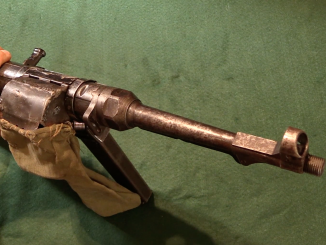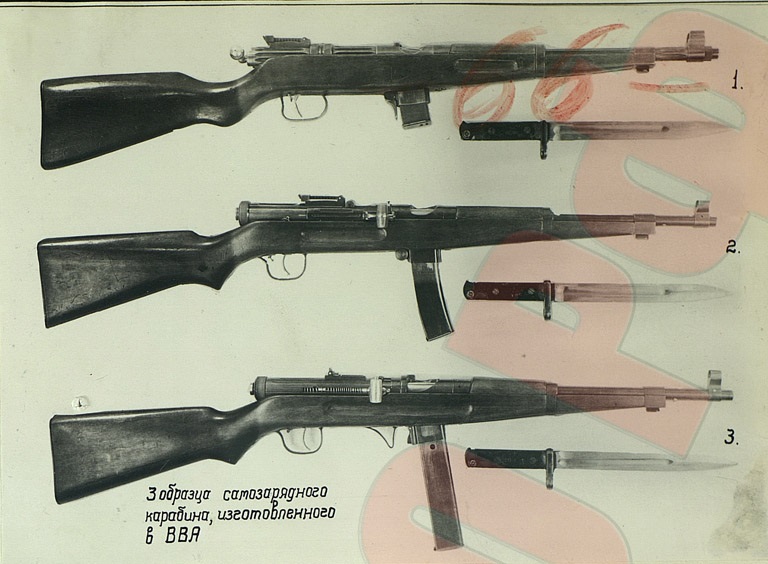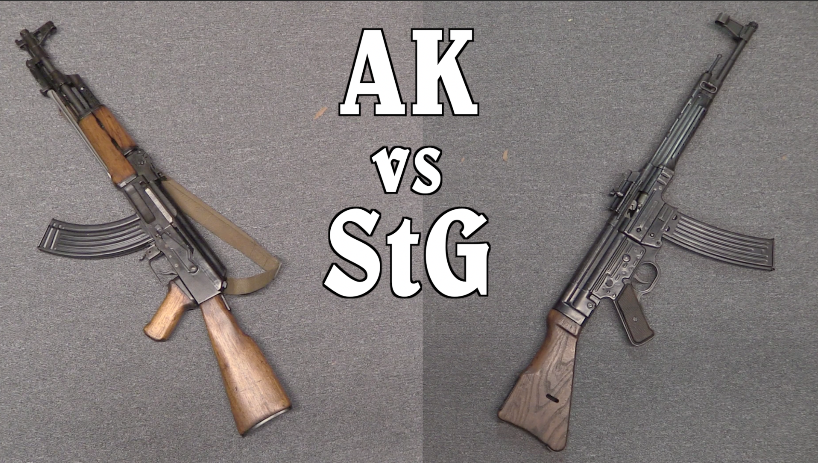I have an SVT-40, but haven’t had a chance to really put it through the paces and do a video on it yet. So I was interested to watch when I saw that Balázs Németh at Capandball.eu put up a video on the rifle. He usually does excellent work, and this was no exception. We all sometimes have a tendency to cast a particularly flattering light on guns that are expensive or rare, and it is refreshing to see Balázs give the SVT a more realistic assessment.
Related Articles

Modifications
Ukrainian or Russian Partisan Modified MP40

Prototype
Mayn Experimental Carbine

Select-fire Rifles

I too purchased a well used SVT and although obviously used heavily it still cuts 2X2’s darn easy… Going to use on bear this hunt!!!
Finland.. Finland.. Finland
Yeap we surely showed how to make a fight for the money.
1942-44 we lost the ball, during the lull of war, but summer 1944 we gave em hell!
Btw: which three european (warring) cities were not occupied during WWII?
London (saved by the see) Moscow (saved by the winter) and Helsinki (saved by the finns)
Well, if you mean that Finns were wise enough to see where war is coming and decided to jump out of the German train to Hell and strike a separate truce with Soviet Russia, then you’re right
yes, indeed, Finns gave one hell of a fight, but honestly, how much chances tiny Finnish army would have against just one of Soviet Fronts of the 1944-45 period?
>Moscow (saved by the winter)
I think that Mannerheim line would have a much shorter lifespan during a good, if rather short, Karelian summer rather than harsh winter.
Soviet army learned its winter warfare lessons the hard way; German decided to go out and make their own mistakes. Served them right.
I see the similarity Ian mentioned a few days ago between the SVT gas piston system and that of the German G43.
I also notice that except for that separate gas piston assembly, the SVT’s action field-strips very much like the later AK.
An example of “if it ain’t broke, don’t fix it”, I suspect.
cheers
eon
What author of video calls “gas piston” is actually extension rod. Besides detail of terminology, one thing crossing my mind is: with such a slender object, how is it kept against bending. Is it supported in middle of length elsewhere?
You are correct, a truly excellent
video. Very well done and quite entertaining.
I would second his warning about safety glasses. Be sure you check out a Tokarev. My dad had one with the same firing pin problem. It did not destroy the rifle, but it did expand the chamber making it unsafe to fire further.
Self-loading rifles have long history in Russia. First serious test concerning self-loading rifles were done in yet tsarist Russia in early 20th, it leads to small-scale production of Fyodorov model 1913 rifle (150 examples ordered), the later development were halted by outbreak of First World War. But don’t forget that in tsarist Russia also other self-loading rifles were tested: Tokarev rifles (model 1908, model 1909, model 1910-1911, model 1913), Я. У. Ращипей rifles (model 1908, model 1908-1910, model 1918). Ясников rifle model 1915, as well foreign designs.
The AVS-36 is best known competitor of Tokarev SVT-38 and SVT-40, but don’t forget that in Soviet Union in 1920s-1930s wide array of self-loading rifles were created:
Tokarev model 1926 – 6.5mm Arisaka cartridge, magazine capacity: 10, operation principle: short-recoil. Tests showed that this rifle wasn’t enough durable.
Tokarev model 1928 – improved model 1926 for 7.62mm Mosin cartridge. As model 1926 fail to pass tested. Further development was abandoned because ГАУ (Main Artillery Directorate) requested gas-operated self-loading rifles.
Degtyaryov model 1929 – 6.5mm Arisaka later 7.62mm Mosin cartridge, operation principle: gas, magazine capacity: 5, 10 or 15. Tests showed that this rifle was prone to jamming and many parts have short life.
Degtyaryov model 1930 – improved model 1930, still have malfunctions (for example extractor breaks easily) but it was anyway ordered to small-scale production. Results were negative: chance of jam was over 25%. Production was halted.
Tokarev model 1931 – 7.62mm Mosin cartridge, gas-operated, magazine capacity: 10. Tests showed that this rifle was prone to jamming and heavy.
Tokarev model 1932 – 7.62mm Mosin cartridge, lighter than model 1931
Simonov model 1933 – 7.62mm Mosin cartridge, magazine capacity: 15, gas-operated, it has several flaws, it was used to create improved model called “0-36”
Мощевитин model 1934 – 7.62mm Mosin cartridge, locked-forward-moving-barrel-operated, magazine capacity: 5. Test showed very harsh recoil, but it was very reliable (chance of jam: 1-2%). ГАУ requested development of machine gun working on this principle, so the self-loading rifle was abandoned.
Безруков model 1935 – 7.62mm Mosin cartridge, gas-operated, magazine capacity: 5. It has several flaws: among others it was long and heavy.
Simonov model 1935 (also called “0-20”) – 7.62mm Mosin cartridge, it was improved model 1933 rifle. Test showed that it was prone to jam, some part has short life.
(For more information see: В.Е. Маркевич Ручное огнестрельное оружие)
Interesting info on Red Army platoon-level organization.
Photos I’ve seen seem to indicate wider distribution of the Tokarev among naval infantry than among line riflemen. I wonder if this is accurate.
They seem to have been popular in Red Square parades too.
штат 4/400-416 (April 1941) states that Rifleman Division should have 3 Rifleman Regiment (summary) equipped with:
441 automatic pistols, 313 sub-machineguns, 1301 rifles & carbines, 984 self-loading rifles, 116 automatic rifles & LMG, 54 MMG, 6 AA MG, 3 AA 12.7mm MG
I forgot to write that above cited numbers concern Red Army. The RKKF (Soviet Navy) formed Naval Riflemen Brigades (Russian: морская стрелковая бригада) which should have 3 Independent Riflemen Battalions (батальон) each having 715 (above cited 3 Riflemen Regiments has 2557 soldiers, 3 Riflemen Battalions 3*715 = 2145), whole Riflemen Brigade has following fire-arms:
149 LMG & MMG
612 PPSh SMG
48 AT rifles
Interestingly Naval Riflemen Brigades have Independent sub-machine gunners Company (отдельная рота автоматчиков)
A few notes I’d give to anyone with an SVT-40:
-The accuracy with these is very hit-or-miss regardless of bore condition. The problems stem from the fitting of the barreled-action into the stock, particularly below the gas system where the barrel sits. The historical method of alleviating this is to use wood chips to shim the space between the barrel and stock. I’ve tried this, and it does seem to help.
-There’s a real tendency for these guns to get extremely hot around the receiver bridge regardless of whether they are repeatedly shot or not. It seems that the barrels are quite thin and the heat generating from the chamber area will eventually get the stock and handguards quite hot. Use gloves or be careful!
-Stripper clips actually work quite well if they are OEM and not aftermarket. If they are cheaply made and not mil-spec, there’s a tendency for them to wiggle and get stuck in the magazine. If you can’t find an extra mag for cheap, the next best thing is simply to-spec stripper clips.
-Last note: unlike in the video when the gun is being disassembled, you should NOT remove the recoil spring before the bolt group. The springs like to get bent and become useless if you do this. The better way: after removing the dust cover, pull the entire bolt group back and tilt it out of the receiver with the recoil spring following it. This will help your springs from binding and causing malfunctions.
Your last remark is useful. I experienced same problem with stripping of vz.52 rifle. Kinked up spring is bad.
I like the the Russian small arms they understand K.I.S.S.
Yes, and usually the Soviets killed anyone who had great ideas but a bad relationship with Stalin! Notable aviation guys like Polikarpov, Petlyakov, and Lavochkin were forced to make their planes while in shackles (or with assassins holding suppressed Nagant revolvers to their backs) and Kalinin was executed for the failure of his huge K-7 bomber program. Ilyushin was probably relieved to find that the Il-2 turned out to be the most important plane for the Red Army since this saved him from getting shot at the same time.
If you have ever detail stripped a SVT-40, there is nothing K.I.S.S. about it. Simple on the field stripping, absolute nightmare if you take it apart too far (which was probably a real problem with peasant farmer conscripts from the steppes).
It’s a very impressive design. Relatively simple and pragmatic. It’s surprising the Germans didn’t take a sample over to Mauser and say “Make this in 7.92×57.”
Self-inflicted wound.
The Germans were obsessed with not drilling gas ports in barrels, hence the G41s.
Seems like some simple glass-bedding on the lower stock would tighten the shot groups.
Did the Finnish do any work on the ones they captured? I know they re-barreled at least some of the Mosin rifles they ended up with.
Mechanically are you better off with a Finnish capture or one that the Russians re-arsenalized?
Nick- As far as I can tell the only thing the Finns did differently was bore out the gas port holes so that each setting bled off more gas, thus giving the rifle more functionality when it was fouled heavier and under more adverse conditions.
Good work on part of Balazs!
One thing which sticks out on this rifle is magazine with its unusual curvature. I am sure it took a bit of development to get top rimmed round repeatedly ahead of next to prevent snag in feed-way.
The benefit of this work came to good use later by Dragunov.
Anybody have any ideas on magazines that can be modified to work in the SVT? I was thinking zB-39 magazines, but i’m not sure.
I have compiled WWII footage of the SVT38/40 at http://imgur.com/a/w4evt if anyone is interested.
Two springs on one rod? Could this be a fix for a kinked original?
No, they are all like this.